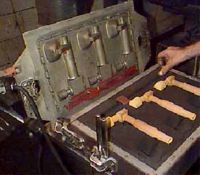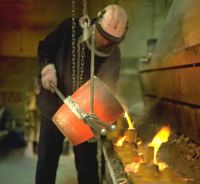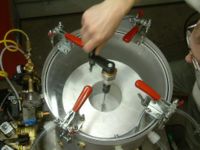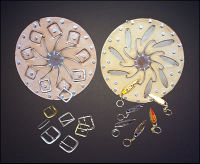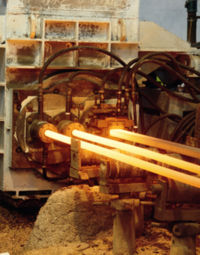Casting
From DDL Wiki
When manufacturing shapes that are too complex or costly to simply cut, a casting process can be used. Casting is the process whereby a solid is obtained from a molten material, such as metal or plastic, poured into a mold. There are many types of casting, many of which are specifically tailored for use on a certain molten liquid. Some types of casting are designed to force the molten liquid into the mold under great pressure, to ensure that the typically viscous molten material completely fills the mold. Examples of this are vacuum or centrifugal casting. Several types of casting are described in detail below.
Casting is an excellent and economical process for making identical copies of an object. Even very small details can be cut into molds, so casting can be used for anything from jewelry to an automobile part. The difficulty in casting is obtaining an accurate mold, so casting does not make sense if you only want to make a handful of parts. However, once the mold has been made, each new copy of the object has a relatively low unit cost and manufacturing time, compared to other processes such as milling.
Casting also wastes/destroys no material, another advantage over removal processes.
The designer of a part for casting should realize that molding parts is not always as simple as it seems. Usually, when a part is first cast in a mold, there are problems with the molten liquid flow. It often takes a few iterations of mold design before reliable parts can be created. Cast parts should be designed to be solid. Also, care must be taken to consider what type of casting will be used. Processes such as sand casting require 2 piece molds, and where the mold splits between the 2 pieces must be considered. However, one advantage to casting is that there is a wide verity of materials that can be cast. Anything that can be liquefied pored and then set can be cast. Almost all metals can be cast but so can certain kinds of plastic, concrete, clay, and plaster
Contents |
Problems
Castings will often shrink when they cool due to solidification and temperature differences. Different materials have different shrinkage rates. Shrinkage can sometimes cause problems because it weakens the cast by leaving cavities. One way of dealing with this problem is to oversize the pattern by 1-6%. Another solution is to include risers, often called feeders, in the cast. Risers pump additional material into the cast as it solidifies.
Types
Sand Casting
Sand casting mainly used for making large parts. Generally iron is the material used for the casting. As the name suggests, sand casting is a type of casting where metal is poured into a cavity made out of sand. Because of the nature of sand, the surface finish after the process of sand casting is grainy in appearance.
Investment Casting:
One of the oldest processes for metal forming is Investment Casting. This process uses a wax as the mold for the hot metal. This rather complicated process can most easily be described as a series of dipping and coating a positive of the metal, until a sufficiently thick shell remains to be used as the mold.
Vacuum Casting:
Vacuum casting utilizes vacuum pressure to force the heated and liquified material into the mold. It can be used to make small and detailed metal parts. Various gasses can also be introduced into the process to improve the process to remove pores and prevent oxidation during the casting.
Centrifugal Casting:
Similar to vacuum casting, centrifugal casting is ideal for casting small and detailed parts. However, instead of using a vacuum force to draw the metal into the mold, molten metal is forced into the mold by centrifugal force. Apart from forcing the molten metal into a fixed mold, this process can be used to create symmetrical objects such as metal wheels or cymbals.
Continuous Casting:
Continuous casting is a process used when high-volume constant cross-sectional pieces are needed. For example, stock products, such as angled-aluminum are made using a continuous casting process. In this process the material being used is heated to a molten state. It is forced through a mold by gravity, typically no bigger than 0.5 meters. The metal is then shaped and continues to slide downward (sometimes curved to horizontal) while being cooled. This process is non-stop and pieces are simply cut off while moving to the correct length.
References
http://www.efunda.com/processes/metal_processing/centri_casting.cfm
http://www.pyrotek-inc.com/section.asp?id=150
http://www.efunda.com/processes/metal_processing/die_casting.cfm
http://www.efunda.com/processes/metal_processing/sand_casting_design.cfm
